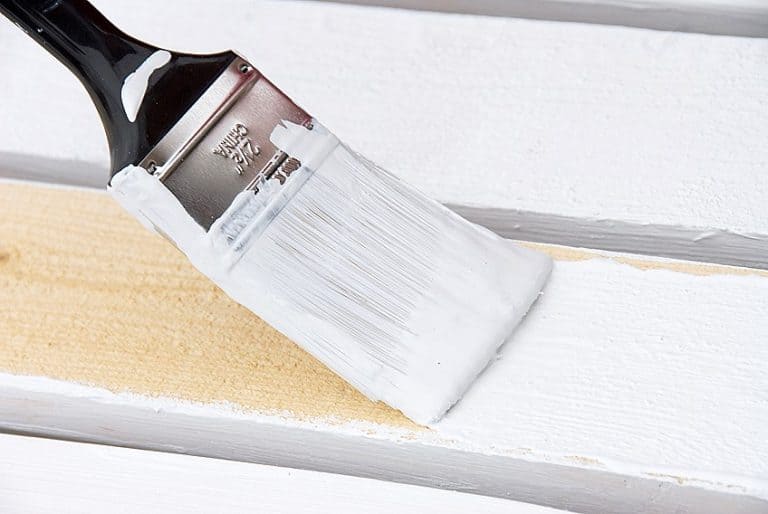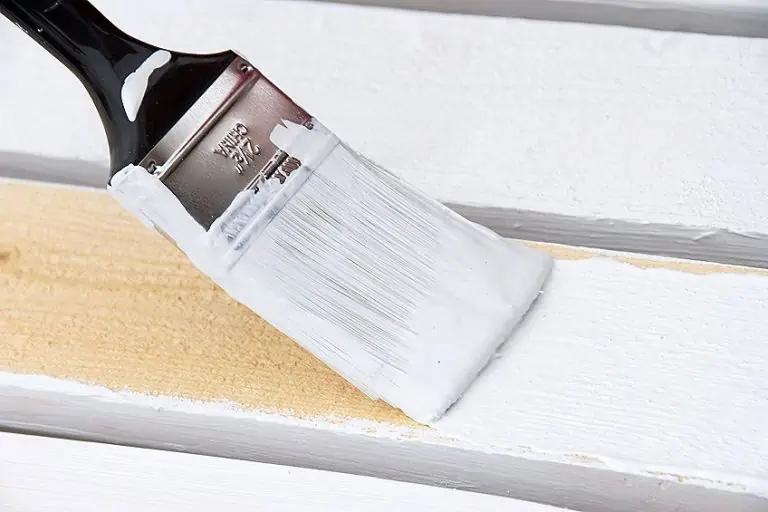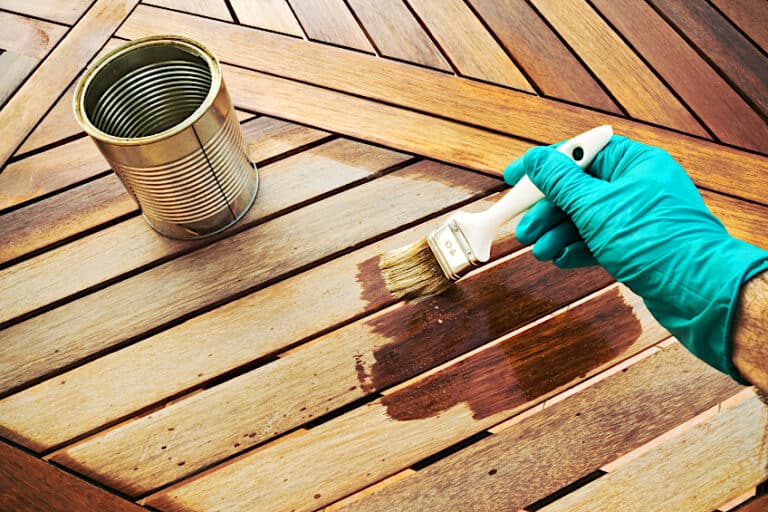Oil vs. Water Based Stain – Choose the Best Stain for Your Project
There are many ways to beautify your wood’s surface. You could choose a brightly colored paint, a sleek and modern veneer, a healthy coat of varnish, or a beautiful coat of wood stain! Wood stain is arguably the best way to improve the overall look of your wood without sacrificing its texture and natural form. There are many types of wood stains on the market, from gel-based stains to lacquer-based stains, and the most popular two are oil and water-based stains. These two are generally considered to be the most effective, but which one is best? Let’s have a look at the oil vs. water-based stain debate, and see what exactly these stains are, and how they stack up against one another!
Table of Contents
Oil vs. Water-Based Stain: The Basics
Oil-based stains and water-based stains are some of the most commonly used stain types around the world thanks to their ease of use and accessibility. These stain types are functionally the same but have some key differences that make them ideal for their respective applications. The core difference between the two is that oil-based stains use tung or linseed oil as a base, whereas water-based stains use (as the name suggests) water as one of the base components.
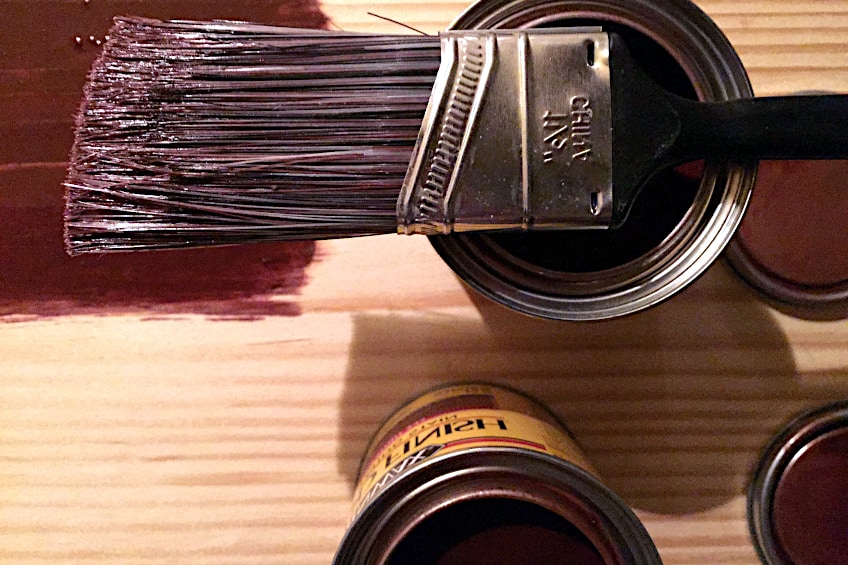
As a result, the different types of stain provide different color intensities and vary considerably in their durability over time. Oil-based stains are generally more durable, while water-based ones tend to be less so. Whether you choose water or oil-based stain for your workpiece depends on the type of wood you’re working with, the application of your workpiece, and, of course, your personal preference.
Oil-Based Stain Characteristics
Oil-based stain consists of linseed oil that acts as a base catalyst, allowing it to absorb into the fibers of a wooden workpiece. Once the stain has been absorbed, it bonds permanently with the wood fibers, providing not only a deeper color but a layer of protection against various forces such as impact, abrasion, moisture, insect infestation, and fungi.
Oil-based stains are the most durable type of stain. When choosing between water or oil-based stain, durability can be the deciding factor, especially if your workpiece will be exposed to the elements. However, oil-based strains do take a bit longer dry compared to water-based ones due to their consistency and the inherent nature of linseed oil in its composition.
On the other hand, they tend to be a bit gentler with the grain of wood. Oil-based stains, unlike water-based stains, do not raise the grain of wood once absorbed. A raised grain isn’t necessarily a bad thing, in fact, you might even be looking for this type of finish. However, because the oil-based stain is less viscous than water-based stain, it will simply absorb into the grain of the wood without incident. Oil-based stain seems pretty good overall, right? Well, there are a few drawbacks to oil-based stains besides their drying time. Some (if not most) oil-based stains contain VOCs (volatile organic chemicals) that are harmful to the environment. These VOCs are emitted during the drying process thanks to the evaporation of solvents.
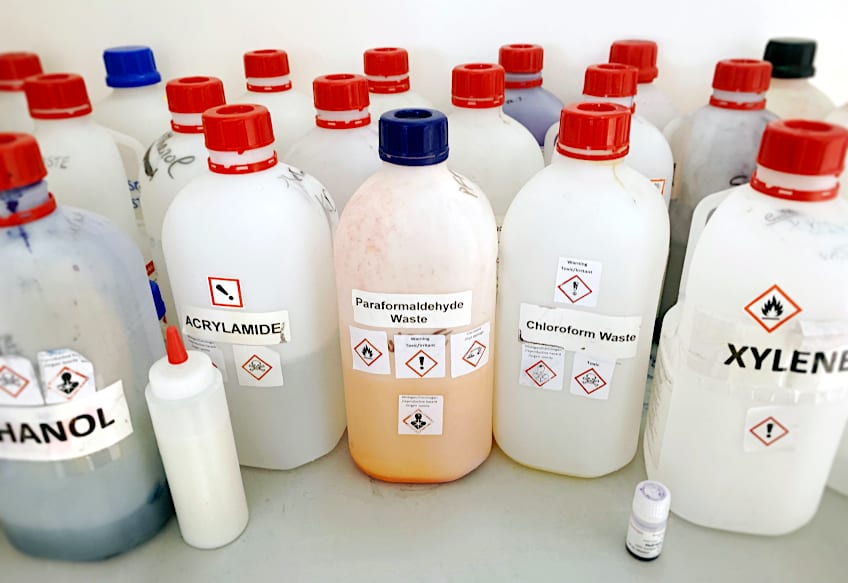
Oil-based stains produce amazing colors though. They tend to provide a rich, darker hue to the wood’s existing color that is instantly noticeable, unlike water-based wood stains that provide an opaque finish to the wood’s surface. That being said, color intensity is generally a personal preference, especially for purely aesthetic workpieces.
- Highly durable
- Darkens wood color
- Readily available
- Easy to use
- Dark enough to hide minor imperfections
- Strong color and finish
- Typically requires only one coat
- Contains VOCs
- Long drying time
- Easy to overapply
- Requires special products to clean off
- Cannot be used in an enclosed environment
- Wood grain is less visible
- Difficult to clean up when spilled
Water-Based Stain Characteristics
Water-based wood stain is the more environmentally friendly option but tends to be less popular overall compared to oil-based wood stain due to its finish. Unlike oil-based wood stain, water-based wood stain consists of a water base with a color agent suspended in the mixture, much the same way that latex-based paints are. Water-based wood stain is also quite easy to use.
As we mentioned previously, water-based wood stain is the environmentally friendly option between the two thanks to the absence of VOCs in its composition. This means that water-based wood stains can be used indoors safely, and thanks to its thinner viscosity, it tends to stretch further than its oil-based counterpart.
Water-based stain is not without its drawbacks though. Water-based wood stain is nowhere near as durable as oil-based stain due to its latex base. This means that water-based is not suitable for outdoor use, or in areas with high foot traffic. However, water-based wood stain does tend to dry significantly quicker than oil-based stain due to how it interacts with wood once it has been applied.
Unlike oil-based stains that seep into the wood’s pores, water-based stains are applied to a wood surface and once the water/latex base has evaporated the pigment that has been left behind adheres to the wood fibers. In this way, it is almost functionally the same as latex paint, with the key difference between the two is that paint is a surface coating and not a wood treatment.

Water-based wood stain is also easier to apply and can be reapplied quicker than its oil-based counterpart. Water-based stain can be applied with a clean cloth, and since it dries quickly a second coat can be applied quickly. This is ideal if your project is time-sensitive, or if you’re a little impatient. That being said, the color produced by water-based stain is less intense which means it’s highly likely that you’ll need to apply a second coat if you’re looking for a solid color change.
- Easy to use
- Dries quickly
- Contains no VOCs
- Readily available
- Easy to clean up
- Difficult to overapply
- Can be applied indoors
- Additional coats can be applied quickly
- Wood grain is more visible
- Color is less saturated than oil-based stains
- Not suitable for outdoor workpieces
- Not as durable as oil-based stains
- Typically requires more coats for an effective finish
- Tends to lift wood grain
The Difference Between Water-Based and Oil-Based Stain
What is the difference between water-based and oil-based stain? Having all the information about water and oil-based stains is all well and good, but have you ever wondered how they stack up against one another? If you have, we’ve prepared a short description of the difference between a water-based and oil-based stain, as well as which applications are best suited for each. If you’re on the fence about which to use, we think this could help you make your choice.
| Oil-Based Stain | Water-Based Stain |
| Highly durable | Not as durable |
| Typically requires one coat | Typically requires more than one coat |
| Contains VOCs | Contains no VOCs |
| Cannot be applied indoors | Can be applied indoors |
| Thick consistency | Thinner, watery consistency |
| Slightly obscures wood grain and texture | Does not obscure wood grain or texture |
| Difficult to clean up if spilled | Easy to clean up if spilled |
| Readily available | Readily available |
| Easy to overapply | Easy to dispense in proportionate amounts |
| Relatively inexpensive | Expensive by comparison |
Oil-based stain does wonders for any wood possessing the porosity to accept its rather viscous consistency. Oil-based stain is widely used across many wood crafting disciplines to achieve a deep, rich color while barely obstructing the grain of the wood at all. This, in addition to the color intensity and durability of oil-based stain, is what makes it such a popular choice.
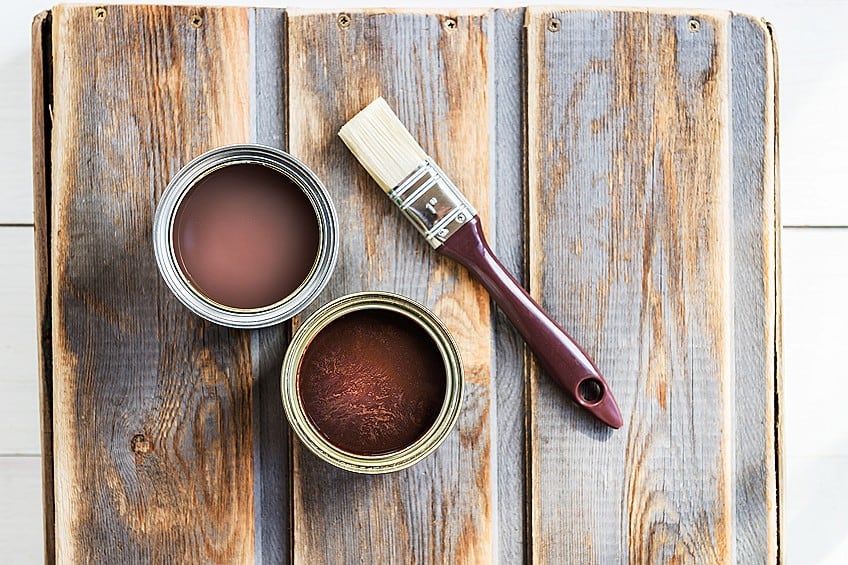
It would be difficult to imagine life without water-based wood stains though. While oil-based stain might seem like the better option on the surface, there are certain instances where water-based wood stain is objectively superior. Water-based wood stain provides a near-opaque finish to wooden surfaces, and since it dries quickly, additional coats can be added in order to darken the tone.
Common Problems
Oil-based stains provide no such luxury, which is one of the reasons it’s so tricky to work with. If oil-based stain is over-applied, it can leave certain sections of your workpiece looking blotchy and uneven. Spot repairing these areas can be tedious and time-consuming, and removing the excess stain can be messy if not done carefully.
Water-based stain on the other hand comes with its own set of drawbacks. While overapplying water stains might not be a complete disaster, it is water-based meaning it will run and create a mess when over-applied. The good news is that water-based stain is easier to clean up, while the (additional) bad news is that water-based stain is expensive to replace should you waste any.
Durability
One of the major selling points of oil-based wood stain is that it tends to be quite durable. This is due to the manner in which the linseed oil interacts with the wood. Oil-based wood stain seeps (slowly) into the wood’s pores and bonds with its fibers. This is what creates the strong color change and ensures that both the interior and exterior of the board are protected from external forces.
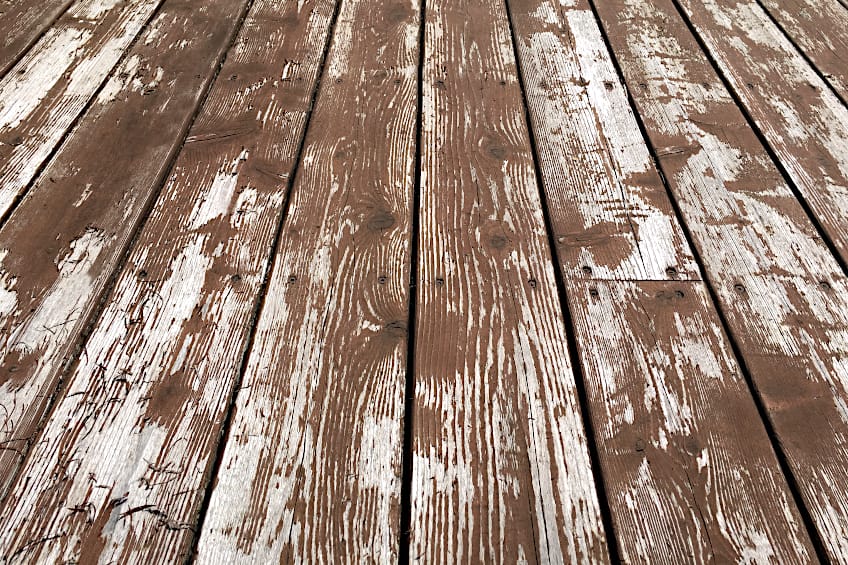
Water-based wood stains, on the other hand, do not provide the same protection that oil-based stains do. Remember, the oil-based wood stain has the advantage of having linseed oil as its base, which provides it with additional properties aside from the aforementioned color improvement. Water-based wood stain is made of (essentially) solvent, latex, and pigment, and therefore provides no protection to the wood.
Color
When it comes to color, many people prefer using oil-based stain due to the prominence of the color it provides. Oil-based stain uses linseed oil as a base, which grants the stain many of the same characteristics of the oil. This deep, rich color is long-lasting and is instantly noticeable on a wooden surface even at first glance.
Water-based stains, on the other hand, do not provide the same tone or color intensity that oil-based stains do. After all, while oil-based stains have the benefit of linseed oil in their composition, water-based ones transfer their color by depositing pigment in the wood grain. This often means that multiple coats need to be applied to achieve a solid finish.
Drying Time
Oil-based stains might provide superior color and durability but this doesn’t mean that they’re always the best tool for the job. Oil-based stains are notorious for their long drying times, which makes them a bit off-putting when time-sensitive projects are at hand. This extended drying time is (like everything else) attributed to its linseed base.

Water-based stains on the other hand are not plagued by this issue. After all, water evaporates over time, which means that within a few hours (or a few minutes depending on the volume applied) your water-based stain will be all dried up. This works to your advantage in time-sensitive scenarios as additional coats can be applied or removed quickly.
Toxicity
Oil-based stains might be great for aesthetics but they’re not exactly environmentally friendly. Oil-based stains contain loads of VOCs which makes them a bit hazardous not only for the environment but for you as well. Oil-based stains should always be applied in a well-ventilated area, and always while wearing the appropriate personal protective gear such as a face mask and gloves.
Water-based stains on the other hand do not have this constraint when being applied. However, some water-based stains do make use of solvent in their composition, which means that even though they can be applied indoors we would still recommend ensuring your workplace is adequately ventilated at all times.
Aesthetic Appeal
Saying that one stain is better than the other wouldn’t make much sense, even when it comes to how they look once applied. Oil-based stains, as we mentioned previously, tend to provide a rich color to wood compared to water-based ones. However, they’re easy to overapply and challenging to apply even if you’ve never worked with them before.

Water-based stains fall on the opposite end of the intensity scale. Generally, an initial coat of water-based stain will provide a near-opaque finish. While this might not be as intense as oil-based stains, your grain and surface texture will still be clearly visible, while the thickness of oil-based stains tends to slightly obscure the grain of the wood.
Pricing
Oil-based stains have been around for a long time, around 100 years in fact. Due to the ease of production and a guaranteed target market, oil-based stain tends to be significantly cheaper compared to water-based stain. However, due to many oil-based stains containing VOCs, they are often passed over for their water-based alternatives.
Water-based stains tend to be more expensive than oil-based ones for a couple of reasons. The most prominent of these is the cost of producing them. They are also not combustible which means that using this stain type reduces insurance costs. Finally, water-based stains are faster-acting than their oil-based counterparts, a feature that seems to have a premium attached to them.
Flexibility
Oil-based stains are known for their stubbornness. Once an oil-based stain has been applied to the surface of your wood it can be quite challenging to get rid of. The removal of an oil-based stain often involves the use of solvents or other dedicated products to get the job done. Additionally, touching up an area where an oil-based stain has been removed typically requires careful blending.
Water-based stains on the other hand have no such problems. If a water-based stain is overapplied or has spilled onto the floor of your workspace, it can be wiped up with a simple cloth. Additionally, water-based stains are easy to patch up and remove, all that you need is some soap, water, a clean cloth, and some elbow grease to get the job done.

Resistance Against UV Damage
If you’re going to be placing your workpiece outdoors, then one of the factors you should consider is exposure to UV light. Oil-based stains tend to provide a decent level of UV protection in most cases, but they tend to do a better job of coloring and protecting your wood from insects and mold than heat and UV damage.
Water-based stains tend to do a pretty good job of protecting wood against the ravages of UV light. This is because water-based stains do not penetrate the wood fibers as deeply, acting more like a surface coating than a wood treatment. This also allows the wood to breathe while preventing UV damage and staving off insects and mold.
Smell
One of the most important factors for a lot of people when choosing between oil-based and water-based stains is the smell. Due to the presence of tung oil in its makeup, oil-based stains tend to smell for a long time even once it has cured completely. This can be a bit off-putting, especially if you intended to use your workpiece immediately in a confined space.

Water-based stains do not have this problem. After all, there is no tung oil or VOCs present in its makeup, which means that wood that is stained with a water-based stain tends to lose its scent fairly quickly after curing. This makes it the ideal choice for application and use indoors, as long as the area is adequately ventilated.
Now that you know what oil-based stain and water-based stain is, what some of their key characteristics are, what they are made of, what they are used for, and which is suited for certain applications, it’s time for you to get out there and put your newfound knowledge to the test with wood stains!
Frequently Asked Questions
Is Oil-Based Stain Better Than Water-Based Stain?
Many wood crafters prefer oil-based stains over water-based stains, but is oil-based stain better than water-based stain? It is challenging to say which is objectively better, as each is better suited for their intended application, making them difficult to compare fairly.
Does Water-Based Stain Smell?
One of the downsides of oil-based stain is the fact that it smells. Does water-based stain smell though? Yes, water-based stain does have an odor to it but compared to oil-based stain, the smell is mild and dissipates relatively quickly.
Is Oil-Based Stain Expensive?
Wood stain is generally quite pricey, but oil-based stain tends to be on the cheaper end of the spectrum. By comparison, gel-based stains and water-based stains are a bit more expensive, due to the manufacturing process and ingredients behind them.

I have been into woodworking since 2005 and woodturning since 2011. Because of my love for wood and woodworking, I started woodhappen.com to teach other enthusiasts about how to finish and seal wood, the best woodworking tools, the different types of wood, and everything else related to woodworking! Read more about me here.



